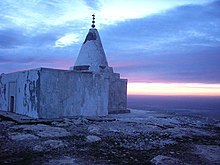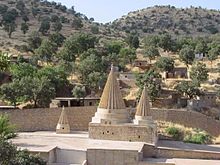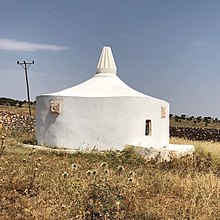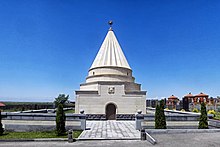List of Yazidi settlements


The following is a list of Yazidi settlements in Iraq, Syria, Turkey and Armenia, including both current and historical Yazidi settlements. Historically, Yazidis lived primarily in Iraq, Turkey, and Syria.[1] However, events since the end of the 20th century have resulted in considerable demographic shifts in these areas as well as mass emigration.[2] Today, the majority of the Yazidi population lives in Iraq and are particularly concentrated in the Nineveh Plains and Sinjar areas in the Nineveh Province in northern Iraq.[3][4]
Today "Êzîdxan" (Land of Yazidis) has an ambiguous meaning as the area has not been defined geographically. Despite this, two Yazidi militias in Iraq are named: the Êzîdxan Protection Force and the Êzîdxan Women's Units (an all-female militia offshoot of the Sinjar Resistance Units).[5][6]
Iraq[]
- Ain Sifni (Shekhan)
- Ba'adra
- Babirah (Fulayfil)
- Bahzani
- Bashiqa
- Barah (Bara)
- Beban
- Borek
- Bozan
- Dohula
- Dughata
- Dugure
- Faysh Khabur
- Gir Zerk
- Gohbal
- Hardan
- Jaddalah (Jidale)
- Khana Sor
- Khanke
- Khatarah
- Khoshaba
- Kocho
- Lalish
- Mahad
- Majnuniyah (Majnuniya)
- Qiniyeh
- Sharya
- Siba Sheikh Khidir
- Simele (mixed population)
- Sinjar (Şingal)
- Sinun
- Sreshka
- Sukayniyah (Sikeniye)
- Tal Banat
- Tal Qasab
- Til Ezer
- Wardiyah
- Zorava
In northern Iraq, Yazidi settlements are concentrated in Nineveh Governorate and Duhok Governorate. Below are Yazidi villages in Iraq organized by district, as listed in Omarkhali (2017: 33):[8]
Northeastern Iraq[]
|
|
|
Northwestern Iraq[]
Listed clockwise from the west:
Turkey[]
This section needs expansion. You can help by . (June 2019) |


- Bahçecik
- Bozca (Xirbe Belek)
- Burç
- Çayırlı (Kefnaz)
- Çilesiz (Mezrê)
- Çörekli (Denwan)
- Değirmencik (Qolika)
- Deveboynu (Geyduk/Geduk)
- Dibek (Badibe)
- Dinçkök (Gede)
- Ekinciler (Inap)
- Güneli (Geliyê Sora)
- Gürses (Davudi)
- Güven (Bacin)
- Işıklı (Zevra)
- Kaleli (Efşê)
- Koçan
- Kumgeçit (Bazivan)
- Kurukavak (Hamduna/Hamdunan)
- Kuşçukuru (Kelhok)
- Mağara (Kivah/Kiwax)
- Mağaracık (Xanik)
- Meydancık (Duşa)
- Oğlakçı
- Oğuz (Şimiz/Şimzê)
- Onbaşı (Şahsîm)
- Oyuklu (Taqa/Taka)
- Sapanlı (Fisqîn/Fiskin)
- Tepeyolu (Tiltirik)
- Üçgül (Minminik)
- Üçkuyular (Feqîra/Fakiran)
- Uğrak (Texerî)
- Uğurca (Qoruk/Koruk)
- Yalınca (Sevdik)
- Yasince
- Yenice (Xarabya)
- Yolkonak (Hicrê)
- Yolveren (Çinare/Çinerya/Çineri/Çinêriya)
Syria[]
- Abu Jarade
- Alaresh
- Antariye
- Awgira
- Ain Dara
- Baflun
- Basufan
- Berzan
- Bur Said
- Chava
- Chelhumiye
- Chetele
- Derdere
- Dogerki
- Drechik
- Feqira
- Gondor
- Gumar
- Gumar Gharbi
- Hasheri
- Jdeyde
- Jidale
- Kerengo
- Khan Temir
- Khirbet Batana
- Khirbet Dilan
- Khirbet Feqira
- Khirbet Jamal
- Khirbet Khazal
- Khirbet Khidir
- Khirbet Khwe
- Kulye
- Lizga
- Mehek
- Mehmudiye
- Merekis
- Merkeb
- Mizgeft
- Morik
- Mozko
- Nasriye
- Otelja
- Qastel Jindo
- Qatma
- Qibar
- Qislachuk
- Slemaniye
- Sheikh Hmud
- Shirkan
- Shukriye
- Tell Aswad
- Tell Beydar
- Tell Eliye
- Tell Hishk
- Tell Khanzir
- Tell Khatun
- Tell Naif
- Tell Sakhar
- Tell Tawil
- Tolko
- Zeydiye
Armenia[]

- Aknalich
- Aknashen
- Alagyaz
- Aratashen
- Arevut (Barozh)
- Arzni
- Avshen
- Balahovit
- Banavan
- Berdik
- Charchakis (Derek)
- Ddmasar (Ghapaghtapa)
- Ferik
- Getazat (Ararat marz)
- Hakko
- Hatsashen (Sabunchi)
- Jamshlu
- Jrarat
- Kanakeravan (Kotayk marz)
- Kanch (Gyalto)
- Kaniashir (Aragatsotn marz)
- Mayakovskiy
- Metsadzor (Avtola)
- Mijnatun (Ortachia)
- Mirak
- Mkhchyan
- Mrganush
- Myasnikyan (Armavir marz)
- Nor Artagers (mixed population)
- Nor Geghi
- Noramarg
- Oshakan
- Otevan
- Ranchpar
- Rya Taza
- Sadunts (Amre Taza)
- Shamiram
- Shenik
- Shenkani
- Sipan
- Sorik
- Tandzut
- Tlik
- Verin Artashat
- Yeghegnut (Badal)
- Yeraskhahun
- Zartonk (Ghamshlu)
- Zovuni
The majority of Yazidi villages are located in western Armenia, in Aragatsotn Province, Armavir Province, and Kotayk Province.
Below are Yazidi villages in Armenia organized by province, as listed in Omarkhali (2017: 35):[8]
Aragatsotn Province[]
|
|
Kotayk Province[]
Ararat Province[]
- Masis
- Mehmandar
- Getashen (Getazat)
- Artashat
- Bagramyan
- Verin Kurdkend (now Norashen)
- Ararat
- Zovuni
- Geghanist
Armavir Province[]

- Karaburun
- Lukashin
- Bambakashat
- Amasiya
- Berkashat
- Pshatavan
- Arevik
- Igdalu
- Arazap
- Badal (now Yeghegnut)
- Margara
- Nizhniy Karkhun
- Araks
- Apaga
- Arshaluys
- Samaghar
- Shahumyan
- Argavand
- Ayarlu
- Oshakan
- Aygeshat
See also[]
References[]
- ^ Nelida Fuccaro (1999). The Other Kurds: Yazidis in Colonial Iraq. London & New York: I. B. Tauris. p. 9. ISBN 1860641709.
- ^ Garnik S. Asatrian, Victoria Arakelova (2014). The Religion of the Peacock Angel: The Yezidis and Their Spirit World. ISBN 978-1317544289. Retrieved 17 May 2019.
- ^ Allison, Christine (2004-02-20). "Yazidis i: General". Encyclopædia Iranica. Retrieved 20 August 2010.
- ^ "Question of the Frontier Between Turkey and Iraq" (PDF). Geneva: League of Nations. 20 August 1925. p. 49.
- ^ "ANF - Ajansa Nûçeyan a Firatê". Retrieved 16 January 2016.
- ^ "HPŞ benennt sich in HPÊ um: Hêza Parastina Êzîdxan – ÊzîdîPress". 2015-11-17. Retrieved 16 January 2016.
- ^ Furlani, Giuseppe (June 1937). "The Yezidi Villages in Northern Iraq". The Journal of the Royal Asiatic Society of Great Britain and Ireland. Cambridge University Press. 69 (3): 483–491. doi:10.1017/S0035869X00086056. JSTOR 25201557.
- ^ a b Omarkhali, Khanna (2017). The Yezidi religious textual tradition, from oral to written: categories, transmission, scripturalisation, and canonisation of the Yezidi oral religious texts. Wiesbaden: Harrassowitz Verlag. ISBN 978-3-447-10856-0. OCLC 994778968.
- ^ Rohat Cebe, Ersoy Soydan. "Batman Yezidis and Yezidis Oral Tradition" (in Turkish). Batman University: 1143–1152. Retrieved 9 June 2019. Cite journal requires
|journal=(help) - ^ Muammer Ulutürk (2013). "Etno-Dinsel Bir Topluluk Olan Ezidilerin Batman ve Çevresindeki Son Yerleşim Yerleri ve Nüfusları Üzerine" (PDF) (in Turkish). 8 (5): 841–848. doi:10.7827/TurkishStudies.4562. Retrieved 9 June 2019. Cite journal requires
|journal=(help) - ^ "İnsan Hakları Batman Platformu, Batman'daki sığınmacı ve mültecilere ilişkin gözlem ve tespit raporu" (PDF) (in Turkish). Insan Hakları Derneği Batman. 3 March 2015: 1–24. Retrieved 9 June 2019. Cite journal requires
|journal=(help) - ^ Sebastian Maisel (2014). Yezidis in Syria: Identity Building among a Double Minority. Lexington Books. p. 19. ISBN 9780739177754.
- ^ Hovsepyan, Roman; Stepanyan-Gandilyan, Nina; Melkumyan, Hamlet; Harutyunyan, Lili (2016-03-01). "Food as a marker for economy and part of identity: traditional vegetal food of Yezidis and Kurds in Armenia". Journal of Ethnic Foods. 3 (1): 32–41. doi:10.1016/j.jef.2016.01.003. ISSN 2352-6181.
- Yazidi populated places
- Iraq-related lists
- Geography of Kurdistan
- Syria-related lists
- Turkey-related lists